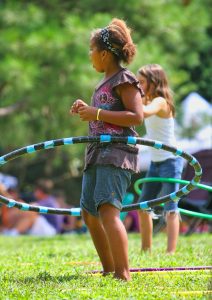 As a kid, I wasn’t a big fan of physical education (or PE, as it is more commonly known). I recall standing in lines doing stretches for what seemed like hours, and then having “free time” to play with hula hoops and those tiny little square scooters. It was chaos, and I didn’t (and still don’t) like chaos. Plus, it’s been several decades and I still can’t hula hoop.
As a kid, I wasn’t a big fan of physical education (or PE, as it is more commonly known). I recall standing in lines doing stretches for what seemed like hours, and then having “free time” to play with hula hoops and those tiny little square scooters. It was chaos, and I didn’t (and still don’t) like chaos. Plus, it’s been several decades and I still can’t hula hoop.

Later, in high school, I remember changing mid-day into shorts and t-shirts only to sit in the bleachers until the bell rang, because it wasn’t cool to actually shoot baskets or jog or otherwise move your body. Only the losers did that {insert facepalm emoji}.
Now, as a mom of elementary age kids and a college professor with a PhD in Kinesiology, (the study of human movement) I am beyond delighted that my kids love PE.
PE is fundamental
Reading is fundamental, but so is physical activity. In fact, there is ample research showing that children who are physically active do better academically. We also know that children who learn motor skills at a young age are more likely to be active later in life (see here and here for a couple of studies emphasizing this point), which likely translates to improved health and lower risk of chronic diseases like heart disease or diabetes.
There are some really simple ways to subtly but powerfully advocate for the value of physical education in your own home with your own children.
#1: Please don’t call it ‘gym.’
You wouldn’t refer to a cooking class as ‘kitchen,’ so please don’t refer to PE as ‘gym.’ I’m on my soapbox a bit now, but this designation lends itself to the idea that PE class is just play time. While there’s certainly a time and place for kids to simply play—it’s called recess and it’s really important, too—PE isn’t it.
PE is where kids learn and develop important motor skills, improve their physical fitness, and develop an appreciation for sport and physical activity. It’s more structured than play, and its value cannot be overemphasized.
#2: PE class has a teacher, not a coach
Coaches are awesome people who have an incredible impact on the athletes they coach. But PE is taught, at least in Alabama, by certified educators who should be called what they are—teachers. Use of the term “PE coach” suggests that PE is all about sports (it’s not) and that the material learned is inherently different from academic material (it’s not). So please gently, but repetitively, correct your kids and anyone else who refers to their PE teacher as their coach.
Also, if you think that PE teachers are just herding cats in a gym, you haven’t met a good PE teacher. I hope you will one day! My girls’ teacher is incredible; the structure he provides and the discipline he teaches has garnered my utmost respect.
#3: PE is an academic subject.
Here’s a fun fact for the day- originally, most physical educators were trained as physicians. Dr. Dudley Sargent, an Yale-trained medical doctor, is largely credited with developing the discipline of physical education. Today, though PE teachers usually don’t have a medical background, physical educators do have credentials equivalent to teachers in other disciplines, but with particular specialization in their subject area. They are trained to teach motor skills, social responsibility, teamwork, fair play, and physical fitness.
My girls have learned the following from their PE teacher:

- How to move to music through dance instruction,
- How to increase their flexibility through safe and effective stretching,
- That exercise is good for their heart as well as their muscles,
- And much more!
PE class not just play time, so ask your kid what he learned about in PE. Be conscientious about using the word ‘learn.’ Doing so will teach your child that what he learned in PE is just as valuable as what he learned in math.
#4: Treat your PE teacher like any other teacher.
Another way you can reinforce PE’s value to your kids is to treat their PE teacher like their other teachers. If you give a holiday gift to the art and music teachers, make sure to include the PE teacher, too. If you care about your child’s performance in math and reading, make sure you also ask your child how they’re doing in PE.
Perhaps most powerfully, you should check in with the PE teacher once or twice during the school year. Ask them how your child is doing and if there are areas of needed improvement that you should work on at home. Then, actually work on those things at home! This will show your child that movement matters, and the fact that a parent took the time to inquire about PE performance will likely be an encouraging moment for that teacher.
#5: Remind your kid (and yourself) that exercise is medicine.
You may not, and probably don’t, remember what you learned in elementary history lessons. However, you do remember the motor patterns that were developed when you learned to kick, hop, jump, throw, etc. Kids who develop effective motor skills at a young age are more likely to become physically active adults. Physically active adults are healthier and live longer lives, so exercise really is medicine, then! That means we ought to give PE the same level of value that we ascribe to other academic disciplines. But, this starts at home, so don’t underestimate the power you have as a parent to teach your children that PE matters.











